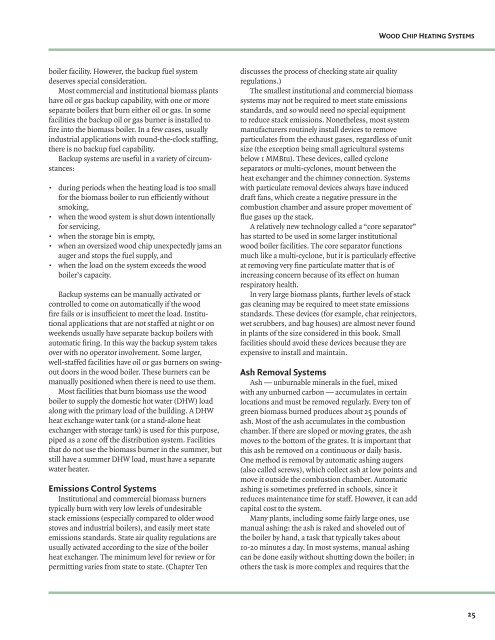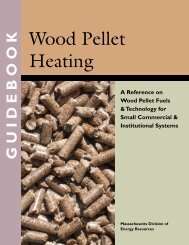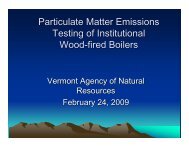Wood-Chip Heating Systems - Biomass Energy Resource Center
Wood-Chip Heating Systems - Biomass Energy Resource Center
Wood-Chip Heating Systems - Biomass Energy Resource Center
Create successful ePaper yourself
Turn your PDF publications into a flip-book with our unique Google optimized e-Paper software.
oiler facility. However, the backup fuel system<br />
deserves special consideration.<br />
Most commercial and institutional biomass plants<br />
have oil or gas backup capability, with one or more<br />
separate boilers that burn either oil or gas. In some<br />
facilities the backup oil or gas burner is installed to<br />
fi re into the biomass boiler. In a few cases, usually<br />
industrial applications with round-the-clock staffi ng,<br />
there is no backup fuel capability.<br />
Backup systems are useful in a variety of circumstances:<br />
• during periods when the heating load is too small<br />
for the biomass boiler to run effi ciently without<br />
smoking,<br />
• when the wood system is shut down intentionally<br />
for servicing,<br />
• when the storage bin is empty,<br />
• when an oversized wood chip unexpectedly jams an<br />
auger and stops the fuel supply, and<br />
• when the load on the system exceeds the wood<br />
boiler’s capacity.<br />
Backup systems can be manually activated or<br />
controlled to come on automatically if the wood<br />
fi re fails or is insuffi cient to meet the load. Institutional<br />
applications that are not staffed at night or on<br />
weekends usually have separate backup boilers with<br />
automatic fi ring. In this way the backup system takes<br />
over with no operator involvement. Some larger,<br />
well-staffed facilities have oil or gas burners on swingout<br />
doors in the wood boiler. These burners can be<br />
manually positioned when there is need to use them.<br />
Most facilities that burn biomass use the wood<br />
boiler to supply the domestic hot water (DHW) load<br />
along with the primary load of the building. A DHW<br />
heat exchange water tank (or a stand-alone heat<br />
exchanger with storage tank) is used for this purpose,<br />
piped as a zone off the distribution system. Facilities<br />
that do not use the biomass burner in the summer, but<br />
still have a summer DHW load, must have a separate<br />
water heater.<br />
Emissions Control <strong>Systems</strong><br />
Institutional and commercial biomass burners<br />
typically burn with very low levels of undesirable<br />
stack emissions (especially compared to older wood<br />
stoves and industrial boilers), and easily meet state<br />
emissions standards. State air quality regulations are<br />
usually activated according to the size of the boiler<br />
heat exchanger. The minimum level for review or for<br />
permitting varies from state to state. (Chapter Ten<br />
discusses the process of checking state air quality<br />
regulations.)<br />
The smallest institutional and commercial biomass<br />
systems may not be required to meet state emissions<br />
standards, and so would need no special equipment<br />
to reduce stack emissions. Nonetheless, most system<br />
manufacturers routinely install devices to remove<br />
particulates from the exhaust gases, regardless of unit<br />
size (the exception being small agricultural systems<br />
below 1 MMBtu). These devices, called cyclone<br />
separators or multi-cyclones, mount between the<br />
heat exchanger and the chimney connection. <strong>Systems</strong><br />
with particulate removal devices always have induced<br />
draft fans, which create a negative pressure in the<br />
combustion chamber and assure proper movement of<br />
fl ue gases up the stack.<br />
A relatively new technology called a “core separator”<br />
has started to be used in some larger institutional<br />
wood boiler facilities. The core separator functions<br />
much like a multi-cyclone, but it is particularly effective<br />
at removing very fi ne particulate matter that is of<br />
increasing concern because of its effect on human<br />
respiratory health.<br />
In very large biomass plants, further levels of stack<br />
gas cleaning may be required to meet state emissions<br />
standards. These devices (for example, char reinjectors,<br />
wet scrubbers, and bag houses) are almost never found<br />
in plants of the size considered in this book. Small<br />
facilities should avoid these devices because they are<br />
expensive to install and maintain.<br />
Ash Removal <strong>Systems</strong><br />
Ash — unburnable minerals in the fuel, mixed<br />
with any unburned carbon — accumulates in certain<br />
locations and must be removed regularly. Every ton of<br />
green biomass burned produces about 25 pounds of<br />
ash. Most of the ash accumulates in the combustion<br />
chamber. If there are sloped or moving grates, the ash<br />
moves to the bottom of the grates. It is important that<br />
this ash be removed on a continuous or daily basis.<br />
One method is removal by automatic ashing augers<br />
(also called screws), which collect ash at low points and<br />
move it outside the combustion chamber. Automatic<br />
ashing is sometimes preferred in schools, since it<br />
reduces maintenance time for staff. However, it can add<br />
capital cost to the system.<br />
Many plants, including some fairly large ones, use<br />
manual ashing: the ash is raked and shoveled out of<br />
the boiler by hand, a task that typically takes about<br />
10-20 minutes a day. In most systems, manual ashing<br />
can be done easily without shutting down the boiler; in<br />
others the task is more complex and requires that the<br />
WOOD CHIP HEATING SYSTEMS<br />
25





